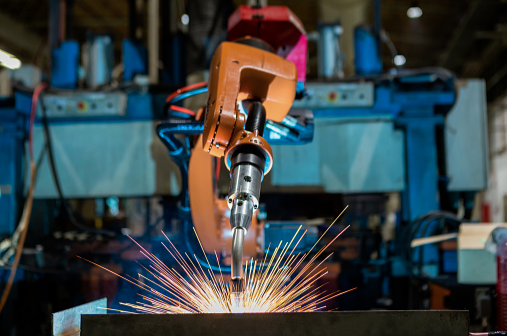
The Advantages of Robotic Welding
The International Federation of Robotics estimates more than 517,000 industrial robots were installed in factories around the world last year, bringing the global total to approximately 3.5 million, with automated welding among their most popular functions.
With the global automotive industry remaining a primary driver and others expanding adoption of automated applications, a 2022 report forecasts the global robotic welding market will grow from $7.1 billion in 2021 to $12.7 billion by 2027. This post spotlights some of the capabilities and most beneficial advantages of robotic welding to help you decide if it’s the right process for your next project.
What is Robotic Welding?
Steel industry partners in automotive, construction and other manufacturing have a long history of introducing and normalizing high-tech innovations. As its name suggests, robotic welding involves advanced technology performing the welding process automatically.
First applied to manufacturing by General Motors in 1962, spot welding in the automotive industry remains the practice’s most popular use, but arc welding is also a popular application as robotic welding types have become as diverse as manual methods.
Some of the best robot welders for carbon steel, stainless steel, aluminum, nickel and copper utilize gas metal arc welding (GMAW), or MIG (metal inert gas) welding. Robotic welding is often best suited for shorter welds or any easily repeatable action that will not necessitate continuous shifts or process changes that one-off, custom jobs can require.
What Are the Advantages of Robotic Welding?
After examining the productivity benefits provided to manufacturers, it’s easy to see how and why automated welding practices have become so popular.
- Automated arc welding produces precise, consistent, and higher-quality welds. While the final performance of any weld will rely in part on the quality of materials welded, welding robots can achieve exceptionally high-quality welds with much more consistency than even the most experienced and technically skilled certified welding inspectors or supervisors. Welding speed, current, and other variables are meticulously maintained, and the length and size of every weld will be virtually identical in a way simply not feasible by human hands.
- Robotic welding saves time. With automated robots rarely needing a break, large runs including thousands of assemblies (or more) can be recreated in short order. Robots don’t tire, get distracted or feel fatigue. With welds quickly repeated or even conducted simultaneously, production speeds are significantly increased. This expedites final products to customers and provides a long-term return on investment over time.
- Automated welding reduces waste and consumables costs. With robot welders working incredibly efficiently, eliminating mistakes means reducing the waste of raw materials. Avoiding unnecessary mistakes and material scrap helps keep projects on (or under) budget. Robotic welding also optimizes efficiency with consumables such as fillers and nozzles, increasing their lifespans to further save on supply costs. Fewer wasted materials also equate to a faster cleanup, saving additional time while less weld spatter allows for shorter downtimes between projects.
- Automated welding helps keep workers safe. General Motors first applied robotic welding on its assembly line to remove human workers from close proximity to the potentially dangerous process. The sparks, fumes and extreme heat produced by welding can create a physically taxing and hazardous work environment. Using robots removes accident and injury potential, ensuring the workflow isn’t interrupted and employees’ safety is a top priority.
Robotic Welding at Westfield Steel
Equipped with and empowered by FANUC ARC Mate 100iB GMAW welding robots, an OTD Daihen FD-V8 GMAW welding robot, and a Vectis Universal UR10e collaborative robot (cobot), Westfield Steel can complete large-scale production orders with both speed and precision. With a versatile six-axis modular construction, our automated welders can access narrow spaces and repeatedly perform strong, consistent welds. Talk to a robotic steel welding expert today to learn how Westfield Steel’s services and capabilities can add value to your next project.
Back